

Metzgete time: How to make your own sauerkraut
Of all the seasons, autumn is my favourite. It's when I can indulge in really good food. Black pudding, ribs and bacon, it's butcher's meat time. And with it: sauerkraut - home-made tastes best by far.
I like sauerkraut so much that I ordered it for lunch on a visit to Alsace this summer. "Choucroute garnie" is what they call it there, garnished sauerkraut. In my case, "garnished" meant: two Wienerli, a large piece of ham, a piece of smoked bacon, a piece of fresh bacon and four potatoes. To be honest, at almost 30 degrees in the shade, that was a bit too much even for me. But the homemade sauerkraut tasted great. That's why I really wanted to make my own sauerkraut this year.
Simple, but time-consuming
The effort involved may be strenuous, but the yield is all the better. It is therefore worth making a whole pot of sauerkraut. You can eat your fill of it all autumn. As much effort as it takes, it's really easy to make. All you need is white cabbage, salt and spices of your choice and a few juniper berries. Ideally, you should have a slicer, a sauerkraut pot and a wooden pestle. I don't have the latter and have therefore found a somewhat unconventional alternative. But more on that later.
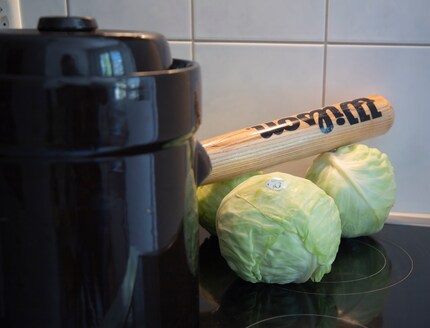
Sauerkraut is produced by lactic acid fermentation. These are bacteria that have naturally colonised the cabbage and convert the sugar in the cabbage into acid. The cabbage turns sour in a natural process, without you having to do anything. All you have to do is create the right conditions for the bacteria to thrive. In addition, no other bacteria or fungi must be allowed to colonise, otherwise all the work will be in vain... so the cabbage ferments away in an airtight container.
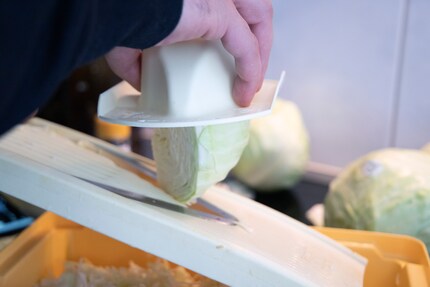
Before you do this, you need to wash the cabbage and put the outermost, whole leaves to one side. But please don't throw them away, as you'll need them later. Cut the remaining cabbage into very thin strips, which is best done with a slicer. If you like, add caraway seeds, juniper berries or other spices. The sliced and seasoned cabbage is then salted. Between 15 and 20 grams of salt are needed per kilo of cabbage. The salt serves several purposes: it draws water out of the cabbage and kills bacteria and fungi that could spoil the sauerkraut.
The perfect way to cope with stress
Now comes the fun part for anyone with aggression problems: In the sauerkraut pot, smash the chopped vegetables properly with a wooden pestle. Because I didn't have one to hand, I used the baseball bat from the editorial team - ghetto style. This way you squeeze out the water and break up the cell structures to make the cabbage nice and smooth.
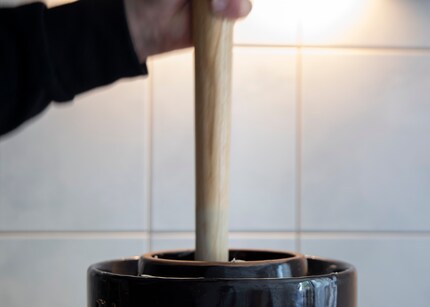
The herb should now have drawn enough water so that it is completely covered with its own juice. If this is not the case, you can help with a little brine: Simply dissolve 30 grams of salt per litre of water. Now cover the shredded and pressed cabbage with the stored whole leaves and weigh the leaves down with stones or clay discs. This prevents air from getting to the vegetables and spoiling them.
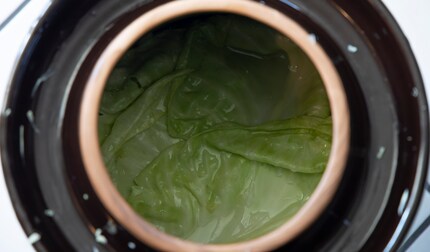

Now put the lid on your fermentation pot and fill the rim with water. This is your second insurance policy, so to speak: no air can get into the sauerkraut pot, but gases can escape from the pot. If you don't have a fermentation pot, you can also ferment the sauerkraut in a closed glass container. However, you will then need to lift the lid once every two days to release the resulting gases.
You now need a little patience. Leave your cabbage to ferment and bubble away at room temperature for a fortnight, then place it in the cellar for a further two weeks. Only then is your sauerkraut ready to ferment. You are welcome to taste it in between and check whether it is sour enough for you. Fermenting is not an exact science, it's more about messing around and experimenting. I like my cabbage best with a little sautéed onion and boiled down in white wine for a long time. It's particularly good when you cook smoked meat with the sauerkraut.
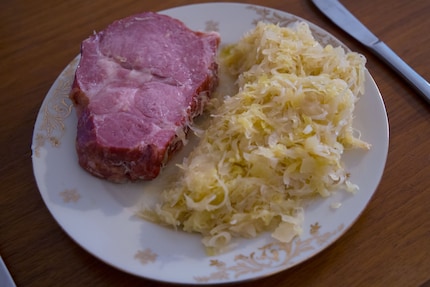
When I flew the family nest over 15 years ago, I suddenly had to cook for myself. But it wasn’t long until this necessity became a virtue. Today, rattling those pots and pans is a fundamental part of my life. I’m a true foodie and devour everything from junk food to star-awarded cuisine. Literally. I eat way too fast.



